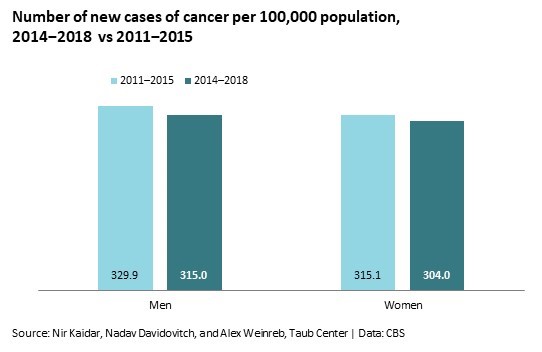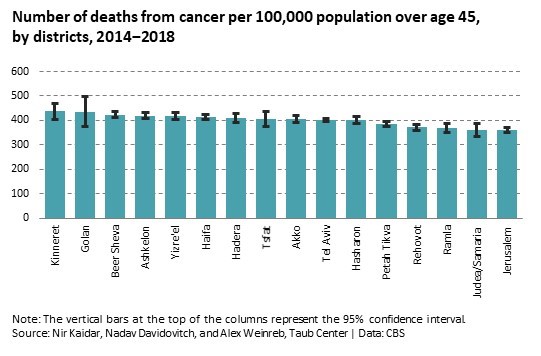The full research is available in Hebrew only.
Cancer is the leading cause of death in Israel among both men and women. It represents a major challenge to the healthcare system, from prevention to early diagnosis through to disease treatment, along with its heavy social and economic repercussions. Taub Center researchers Nir Kaidar, Prof. Nadav Davidovitch, and Prof. Alex Weinreb examined morbidity and mortality rates of cancer in Israel for 2014 through 2018 from three perspectives: national, gender-oriented, and geographic-township.
The study is based on data taken from a demographic, health, and social databases of the Central Bureau of Statistics (CBS), which are organized by geographic districts and allow an analysis of morbidity at the township level. The study findings show that there are distinctions in morbidity and mortality trends between women and men, among other reasons due to exposure to risk factors and differences in health behaviors like smoking, nutrition, and exercise. Thus, at the geographic and town level, there is great importance in the data analysis, since it affords policy makers a clearer picture of cancer mortality and morbidity trends in Israel.
Differences among towns in morbidity rates from cancer
The researchers compared the latest data from 2014‒2018 to previous data from 2011‒2015 and found that, among men, the greatest increase in rates of new cases of cancer was in the towns of Kiryat Malakhi, Maghar, Migdal HaEmek, Ma’alot Tarshiha, and Tayibe, while the greatest declines in rates were in Tamra, Zichron Ya’akov, Hod Hasharon, Kfar Saba, and Karmiel. Among women, the five towns with the greatest increase in rates were Kiryat Malakhi, Tira, Akko, Rahat, and Bat Yam, while the five towns with the greatest decreases were Beit Shemesh, Sderot, Yokne’am Illit, Ramat Gan, and Ramat Hasharon.
Comparing data across the time periods shows a general decline in the incidence of cancer and a drop in the rate of new cases of cancer among men and women; this is true for all types of cancer (for which there are data) except for lung cancer in women, where there has been a rise in the morbidity rate.

A drop in mortality rates from cancer
An analysis of the data on a national level shows a drop in mortality rates among those aged 45 and older: between 2012 and 2016, the death rate from cancer was about 412 men and women per 100,000 population annually, while between 2015 and 2019, this rate fell to 397. Especially low mortality rates were seen in the districts of Jerusalem, Judea and Samaria, Rehovot, and Petah Tikva. An analysis of mortality data by socioeconomic ranking of residential areas shows the lowest rates in those localities with high socioeconomic ranking — a result that hints at more effective care or earlier diagnoses among these populations.





